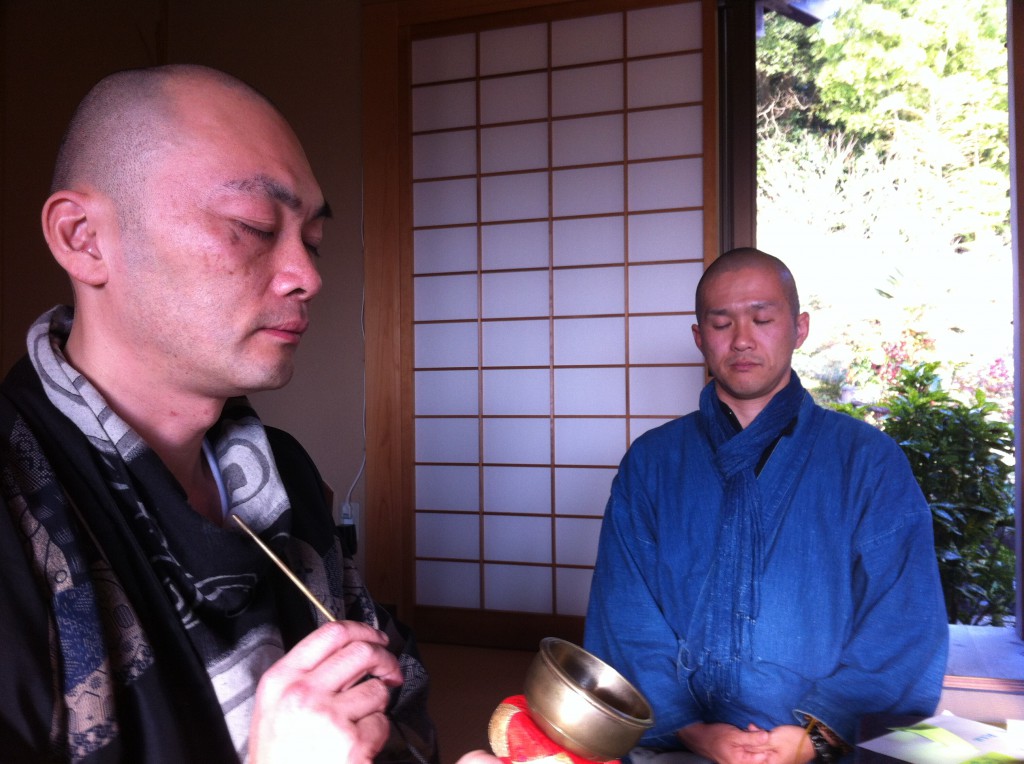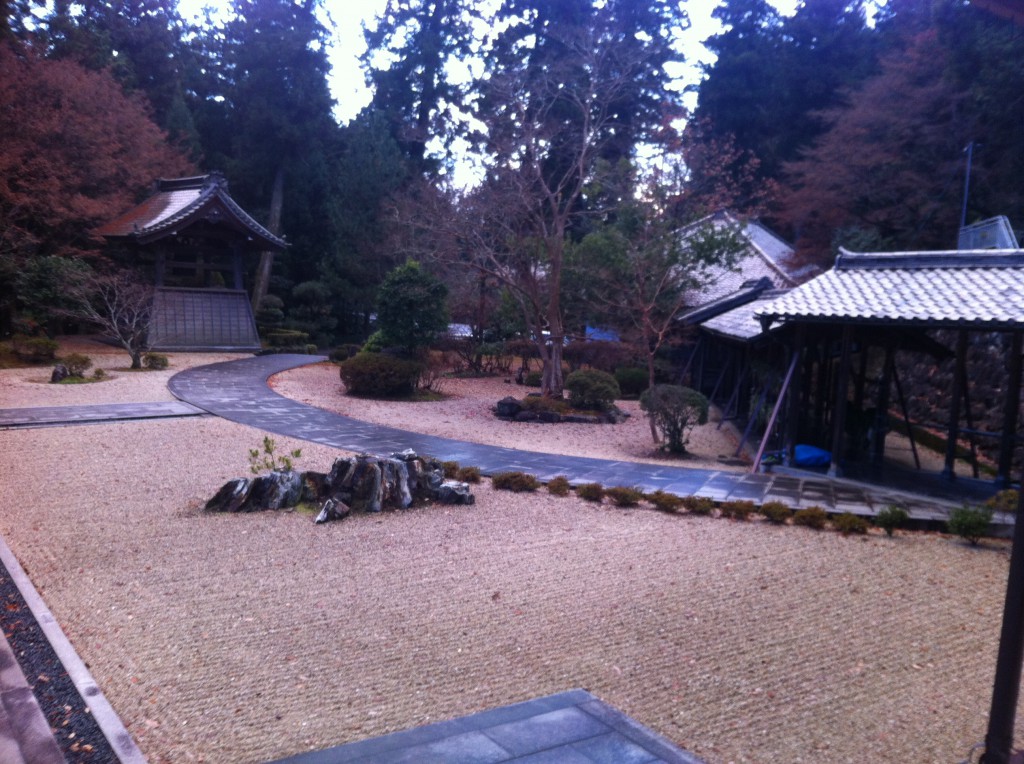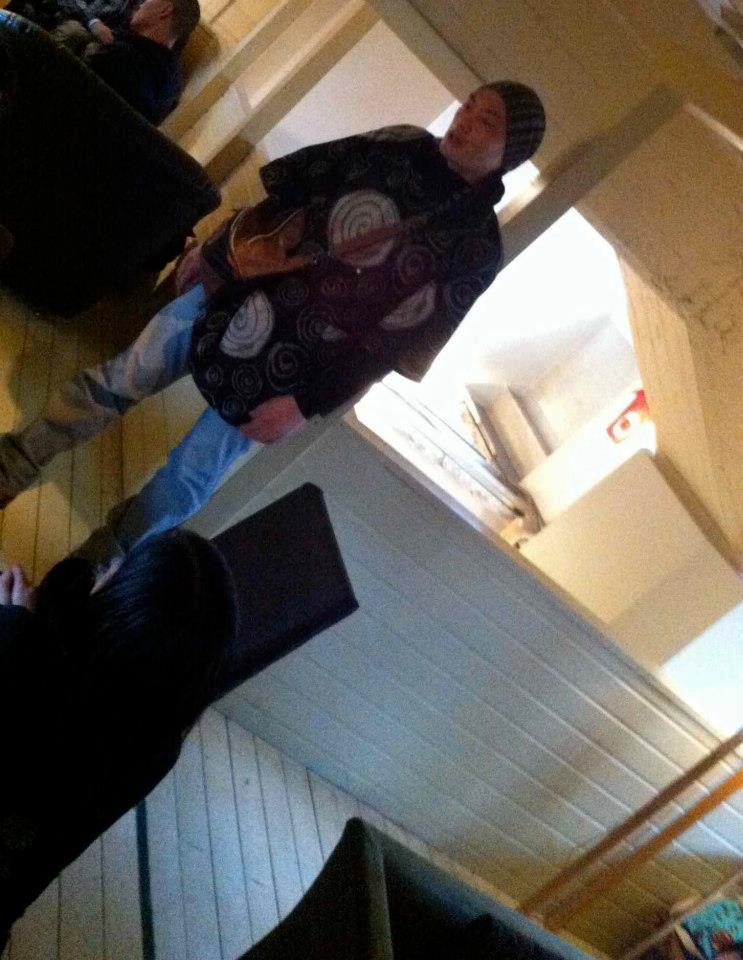2014 Level 1: Seminar 7
The Enlightenment of the Suicidal and a Network for Wellbeing
January 7,2015
Rev. Jotetsu Nemoto

Rev. Jotetsu Nemoto is another suicide prevention priest who after deep immersion in the suffering of the 1st Noble Truth of suicide prevention has begun to further develop his work. Rev. Nemoto is the abbot of Daizen-ji, a Rinzai Zen temple in a rural region of Gifu in central Japan. He was raised in Tokyo but did not grow up in a temple and is one of a minority, only about 25%, who do not come to the priesthood through succession. Born in 1972 and growing up during the height of the bubble economy and its subsequent collapse, his manner, speech, and sentiments are more representative of younger Japanese, many of whom are alienated and have a hard time creating a meaningful life. Experience with suicide in his youth led him in 2004 into a very unique form of engagement with the suicide issue through the internet, developing chat groups and a personalized style of internet counseling and chaplaincy. By 2009, after answering thousands upon thousands of e-mails and telephone calls at all hours of the day and night, his attempt to apply his rigorous Zen training to suicide prevention work gave way to a serious heart condition at only the age of 37 and an extended stay in the hospital.
During his angioplasty surgery and hospitalization, he became further distraught by the lack of sympathy extended to him by many of the people he had been assisting over the Internet. He was shocked to find that all they could think about was their own illnesses and when he might be available again to help them. This experience led him to the first significant shift in his work: to cut back drastically on e-mails and cell phone use and to require that those who wanted his counsel to come visit his temple, even though its location is quite remote. This new approach led to positive results for both the people who visited and for himself. After such face-to-face encounters, he often felt that some kind of resolution has been achieved. In one remarkable case, a man who had been a reclusive hikikomori[1] walked for five hours to get to Nemoto’s temple. Exposing himself to the outside elements and thinking about the personal interaction he would have with a stranger, Rev. Nemoto, were things he hadn’t done in years, and the reflective experience had a deeply therapeutic effect. Upon arriving at the temple, he greeted Rev. Nemoto and announced that he would not be needing his help after all. He then turned around and walked back home.
The achievement of a resolution and the intense interest in the mechanism that leads one either to life negation or life affirmation is a special focus of Rev. Nemoto’s chaplaincy. As we have seen in Rev. Shimada’s work at Life Link, many suicide prevention hot lines and services have stressed anonymity and a lack of follow up with callers, which the government is now trying to change. Further, as we have seen in Rev. Fujio’s work, the popular counseling form of “deep listening” constantly pushes clients back on themselves, away from relying on the counselor or others for answers. While Rev. Fujio and some other priests may eventually invite clients to sit meditation, there is a tendency to stay aware from using direct Buddhist teachings or methods, some out of fear of being perceived as evangelistic. Rev. Nemoto has a different sense as a convert not born into a temple. He uses Buddhist teachings much more actively and prominently in his work, which tends to draw in the younger alternative types more interested in explicit spirituality.
It has been in this recent period of taking in people at his temple and working with them for hours in close personal contact that he has come to understand better this mechanism that can shift people from life negation to life affirmation. This understanding starts from his own training experience in the notoriously brutal monastic life of Japanese Rinzai Zen monks. For months and seasons on end through six years, Rev. Nemoto practiced at nearby Shogen-ji temple?a monastery with a strictly regulated lifestyle where a pecking order of monks from senior teachers on down mind the way of life and practice of juniors, constantly admonishing and sometimes beating them to remind them to remain present always and to investigate “the great matter of life and death”. Week long periods of intensive meditation are usually followed by another week of walking for alms in any kind of weather, while nights are spent in the monk’s small sleeping and meditation spot always exposed to the varying temperatures that remain around freezing for some five months during the year. The never-ending vigilance in practice with elders constantly on the watch creates in the practitioner a liminal state, on the verge of absolute insanity or total enlightenment, satori. This state is well expressed in Larissa MacFarquhar’s extended profile of Nemoto in The New Yorker:
It is as if his thinking mind, his doubting and critical and interpreting mind, had shut down and been replaced by a simpler mechanism that serves the body. The idea is to throw away his self and, in so doing, find out who he is. A well-trained monk, it is said, lives as though he were already dead: free from attachment, from indecision, from confusion, he moves with no barrier between his will and his act.[2]

Rev. Nemoto had his own experience of what could be considered a mini-satori, for he is not completely enlightened yet has experienced a major spiritual breakthrough. During one intensive meditation period, Rev. Nemoto was also serving as the head cook. The combination of being allowed little sleep while meditating intensely and having to deal with the meals of the community lead Rev. Nemoto to a state of collapse by the third day. As he was attempting to carry a heavy pot of boiling soup to serve, he felt that he could not go on and that it would be better to die. However, somehow the training continued to carry his body forward while the mind gave way totally and with it, a deep shift in awareness. The way Rev. Nemoto recounts this episode recalls what Dogen, the great founder of Japanese Soto Zen, wrote in his famous Genjo Koan: “To study the Buddha way is to study the self. To study the self is to forget the self. To forget the self is to be actualized by myriad things. When actualized by myriad things, your body and mind as well as the bodies and minds of others drop away.”[3] At this moment, Rev. Nemoto was suddenly filled with a burst of energy; his body became light as a feather; and experiencing the burden of self falling away left him in a state of overwhelming joy and well being. That evening, he met with his teacher for their regular discussion about the koan that he had been assigned, and, finally, the teacher accepted his response to it.
From this experience, Rev. Nemoto has come to feel that the suicidal resembles the Zen monk in training, pushed into a corner to their utmost limits and the point of madness and despair when life seems no longer relevant or worth living. The difference between the monk and the suicidal, however, is that the monk has been taught the insights of the Buddha into the nature of life and death and of suffering (dukkha). In Buddhism, the mind is the lynchpin for transformation and getting out of suffering; whereas the suicidal sees the problem of life and death and suffering as one that can be remedied through a material means, the killing of the physical self. From a perennial religious standpoint, this suffering is not due to sin but a state of ignorance, and consequently, liberation is understood as a killing of the self, not the body. In a sense, suicide is a misappropriation of means, a physical response to a psycho-spiritual problem.
For Rev. Nemoto, however, the suicidal, in their state of extreme existence, are in some ways closer to enlightenment than the average person, sleep walking their way through life. He feels that if the suicidal, in their state of extreme sensitivity and awareness, can see the difference between physical suicide and spiritual suicide, then they can address their suffering as a monk or a sincere Buddhist follower will do by looking into the nature of the mind. In November of 2013, Rev. Nemoto came to Tokyo to act as a panelist for an event with His Holiness the Dalai Lama to promote engagement among young priests, and took some extra time to meet a woman whom had contacted him about her depression. He described her as coming from an elite background, well educated, and quite smart. However, she developed severe depression, and no amount of counseling or medication was helping her. In this state, she also was unable to sleep without tranquilizers because of sounds that disturbed her in the night. He spent three hours with her in their first meeting; the first hour just listening to her and getting her background, then doing meditation three times, after which he recounts the counseling really happened.
Against what many counselors might do, he invited her in her fragile state to try meditation with him. Over the space of the three sitting periods, this woman experienced three successive insights. The first time she experienced that the mind can calm down and that (disturbed) thinking and thought can stop. This alarmed her a bit, but she also very it enticing. In the second session, she saw that even though thoughts continue to crop back up and flow, there is a silent space of no thought that always exists in the background. This she found quite wonderful. In the third session, she found that sounds and other sense phenomena in the outer environment can act as cues or reminders to return to this state of silent, no thought. Rev. Nemoto then asked her to start meditating at home. She followed his schedule for the first week of meditating at sunset?a practice he has come to enjoy himself?and then started meditating on her own. During the night, she found herself using the disturbing sounds that used to keep her awake in anxiety as cues to return to mindfulness and meditation. She began to see the sounds that were bothering her at night as being in her mind as well as her anxiety being her mind itself. At this point, the sounds stopped. He recounts that when she came to see him one year later, she looked totally different, much healthier both physically and in spirit. Within this period, she was able to give up her sleeping pills and now has returned to her job.
From his temple, Rev. Nemoto has continued to develop group gatherings confronting the issue of life and death from very Buddhist foundations. In the past, Rev. Nemoto had organized events with suicidal people from his chat groups, such as casual get togethers for meals or more organized outings to famous places for committing suicide to learn from and pray for those who had passed before. However, moving on from Internet chaplaincy and developing more face-to-face work, Rev. Nemoto has started to hold events for all sorts of people, not just the explicitly suicidal. For interested people in his wide network and also for specific groups of businessmen and office workers, he has developed death workshops at his temple. One exercise he uses is for participants to imagine they have been given a diagnosis of cancer and have three months to live. He instructs them to write down what they want to do in those three months. Then he tells them to repeat this process with one month left to live; then one week; then ten minutes. An alternative to this method is for participants to write down the ten most important things in their lives, such as possessions, friends, family, even ideas or values. Then, after telling them they have terminal cancer, he instructs them to choose which things they must give up or abandon until they are down to their final thing at the moment of death, which they must also let go off. Another exercise is for participants to act out their existence after their death by going into the main Buddha hall, lying down in a coffin, and putting a white cloth over their face, while Rev. Nemoto conducts a funeral ceremony. Then, they carry lit candles up a hill behind the temple to imagine entering the world of the dead. These exercises create a wide range of emotions from deep sadness in the experience of dying to even exhilaration in the post-mortem experience.

Going beyond his temple, Rev. Nemoto has now created Ittetsu Net, which he
calls “a network for building friendships and for holding workshops for mental
and physical health, emphasizing self care and outdoor activities.” He calls
upon those interested “to think together about fun things, difficult things,
and tomorrow.” One of these events I attended in March 2013 was held in a
public park in the city of Nagoya for practicing yoga and meditation together.
When I talked to Nemoto afterwards, I asked if everyone in the group was suicidal.
He said that he didn’t know and that it didn’t matter. His point was that
the group was more for building a community of people to share experiences
around healthy living and human connection. He said one of the yoga teachers
had been suicidal, as was evidenced by the track marks on her wrist. However,
he did not want to make such a clear-cut demarcation between the suicidal
and the non-suicidal?for the line between them is actually not so distinct?and
to further get away from people feeling stigmatized because of being suicidal
or mentally ill.
In this way, Rev. Nemoto is working on getting deeper at the roots of the suicide problem in Japan by shifting his focus on helping specifically suicidal people one-on-one to working with groups of people sharing a wider range of anxieties and then working to build back communities of connection based around healthy living. Through his years of work, he has found the prevalent model of volunteers and counselors working in a one-way relationship with the mentally ill and disturbed just does not work. Eventually, the former get tired and burned out, and the latter just get tired of them and their flagging commitment, in a downward spiraling pattern. In Ittetsu Net, Rev. Nemoto seeks to build a more dynamic framework of interaction in which a variety of different groups are united in the central ideal of “self-care”. In these activities, people enjoy themselves in a more playful manner, which then draws in an even greater diversity of people. Within this dynamic container, Rev. Nemoto recounts, counseling will take place naturally at these events.
Go to: Part 6: From the Roots of Suicide and Community Collapse to Building a Post-Suicidal Society (Rev. Shunei Hakamata)
[1] A form of social withdrawal particularly acute in Japan, and now in other
parts of East Asia, of those who will not leave their houses or even bedrooms,
often for years on end; estimated now in Japan to be over 2 million such people.
[2] MacFarquhar “Last Call”. The New Yorker, p. 60.
[3] Tanahashi, Kazuaki, Ed. Enlightenment Unfolds: The Essential Teachings of Zen Master Dogen. Boston: Shambhala Publications, 2000.

